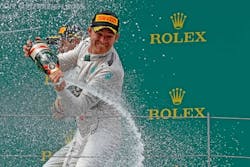Pirelli Report: Austrian Grand Prix
Nico Rosberg won the race commandingly from his Mercedes team mate Lewis Hamilton. Both drivers used the same supersoft-soft strategy, stopping within two laps of each other on laps 38 and 40 respectively.
An early safety car at the Austrian Grand Prix meant that a one-stop strategy was the default choice for the vast majority of competitors. The safety car following the opening lap of the race meant that the cars ran slowly for four laps when they were at their heaviest with fuel.
Despite some spots of rain earlier in the day, the race remained dry with cool ambient temperatures from 16 to 18 degrees centigrade and track temperatures from 24 to 27 degrees centigrade.
All the drivers apart from Pastor Maldonado, Sergio Perez, Kimi Raikkonen and Daniel Ricciardo started on the P Zero Red supersoft tire, which on Friday and Saturday had been about 0.7 seconds per lap faster than the P Zero Yellow soft. With a number of drivers running out of position due to grid penalties and other reasons, some teams chose alternative strategies with long stints to try and boost their final placing.
Red Bull’s Daniel Ricciardo ran for 50 laps on his original set of soft tires, ending up in the points after starting 18th on the grid. McLaren’s Jenson Button, who started last, also attempted an alternative strategy by switching from supersoft to soft on the third lap, but retired before he could reap the benefits.
The teams will now remain in Austria for the first in-season test on Tuesday and Wednesday, where a number of third drivers will be taking the wheel as well as the regular pilots. Unlike last season though, there will be no dedicated Pirelli test days.
Paul Hembery, Pirelli motorsport director: “We initially thought that a one-stop strategy would be more likely today, and this was put beyond doubt by the early safety car. Despite the cool temperatures, the tires performed as we expected them to, with the drivers able to get the most out of their performance.”
